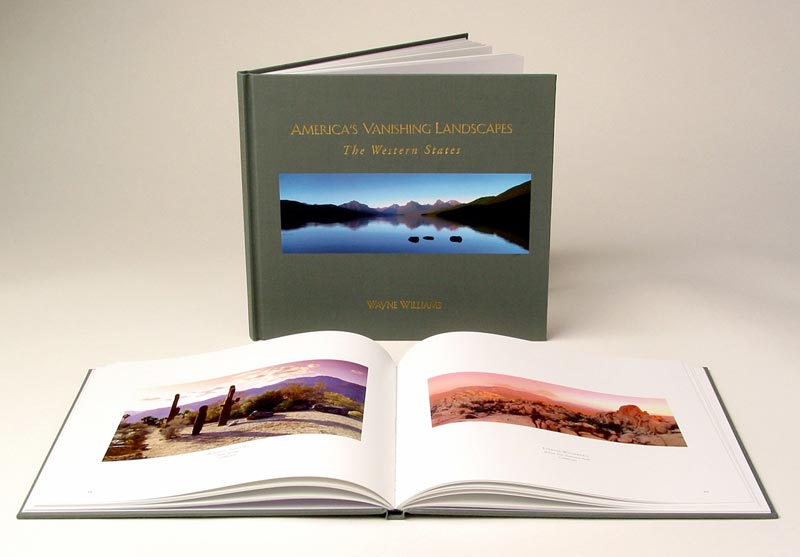A Stunning Tribute to the West’s Rapidly Diminishing Wilderness. Introduction by Prominent Environmentalist Andy Lipkis.
America’s Vanishing Landscapes: The Western States, Wayne Williams’ lyrical photographic documentation of some of our nation’s most ecologically threatened areas, will be released in October by Companion Press of Santa Barbara. (11″ x 11,”, 80 pages, 60 full-color photographs, clothbound, $59.95. Available online here). Or at Amazon.com, at Barnes & Noble stores or online at BN.com. Bored Feet Press 888-336-6199 is the West Coast distibutor.
The book includes an introduction by the prominent environmentalist Andy Lipkis, Founder of Tree People, as well as an essay by Wayne Williams, a Southern California native who grew up during one of the country’s most rapid proliferation of cities, suburbs and resulting urban blight.
America’s Vanishing Landscapes was inspired by Williams’s distress at the diminishing natural world as well as his belief that nature is one of humanity’s most emotionally sustaining elements. A subtle protest of environmental complacency and detachment, it is the first in a continuing series of books and documentaries he has undertaken to continue increasing attention of the starkly fading natural landscape in the U.S. Far from defeatist, his is a refreshingly optimistic vision of what could be our planet’s destiny.
To quote the Los Angeles Times who praised his work: “Imagine a world without pollution, trash or development. No, it’s not a John Lennon ballad but the work of Wayne Williams.”
Eleven states are included in America’s Vanishing Landscapes, from Montana and Colorado, Utah and Oregon, to California and the Islands of Hawaii. Heroic images of mountains, rivers, deserts, forests, lakes and ocean vistas express Williams’ breathtaking vision. His eye for creating vivid images such as Kauai’s Kalalau Valley titled “Valley of Color,” to a haunting Aspen forest grove in “Moonglow” and the majesty of Glacier National Parks “3 Rocks at Lake McDonald” are among the many visual highlights.
“I care deeply about our quality of life, and I see that quality, like our open lands, rapidly vanishing as we continue to rush about our lives,” said Williams. “It amazes me how much man has impacted our planet with not only the basics of homes, roads, fences and power lines, but, air pollution, graffiti and trash which can be found in even the most secluded of places.” In his text he expands further on his concern:
For decades as our population has grown, we take more and more land away from its natural state, crowding it with tightly packed subdivisions and sprawling shopping malls with little care for the physical or emotional loss we feel when Nature is not part of our experience of daily life.
I have a great respect for Nature, feeling that in the pressures of everyday life we can find a healing that comes to each of us from the land itself… as long as we care for it. In return, the land brings us back to a reverential state of mind, something money can’t buy, where we realize that our own personal health and well being, and the health of all people, is directly tied to the health of the land.
Williams’s photographs illustrate that man’s destruction of the landscape is not simply physical, but also cerebral. “People,” he says, “have a ‘fading’ connection with nature, a connection that is presently so tenuous that our minds seem to no longer care about the loss of our natural environment.” He attempts to strengthen this weak bond by transporting the viewer into his photographs through approachable and realistic visions of what is left of the natural world around us.
America’s Vanishing Landscapes takes our nation’s landscapes back in time-to an era before environmental degradation and destruction. By distilling the true colors in nature to unsullied hues and capturing untouched settings, his photography represents landscapes that were commonplace in the lost wilderness of yesteryear. His interpretation, photographic skills and technique unshrouds the landscape from the modern effects of humans and technology, bearing the true spirit of nature.
A recognized landscape photographer and advocate for protecting the environment, Wayne Williams started his photographic career at an early age when given his first camera, a Kodak Brownie that he still owns today.
For over 25 years Mr. Williams has shot editorial, advertising, and illustrative work for clients ranging from Alcoa to Disney, Nissan to TV Guide. In the past 10 years, Williams has applied his photography expertise to the perfection of the Iris print process, creating a body of work that causes many to gasp at the reality of his Limited Edition images, which the book celebrates.
Williams dares to point out a natural world we may soon discover difficult to find both literally and in our imaginations. The works, like panorama windows, aim to bring the viewer into the image, fostering communion, appreciation and ultimately concern for the landscape. A devout nature enthusiast, Mr. Williams has grasped the breathtaking essence of our Western landscape, creating a true labor of love.
The Fine Art photographic print’s from which the book is borne, Iris Watercolor or Piezo Limited Edition prints made on heavyweight art paper, are signed and numbered and available on this site. Exhibitions of the original prints are currently being organized at galleries throughout the U.S.

